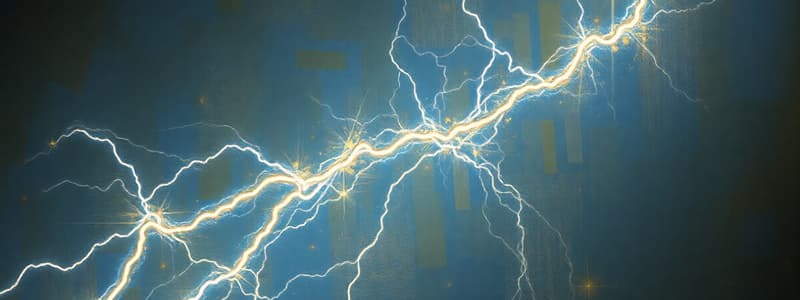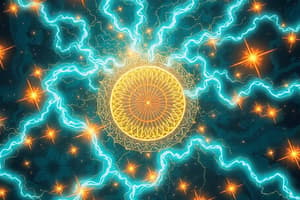Podcast
Questions and Answers
What happens to two charges of the same electrical sign when they are brought close to each other?
What happens to two charges of the same electrical sign when they are brought close to each other?
- They repel each other. (correct)
- They attract each other.
- They become electrically neutral.
- They lose their charge.
If an object is electrically neutral, what can be said about the amounts of its positive and negative charges?
If an object is electrically neutral, what can be said about the amounts of its positive and negative charges?
- Positive charge exceeds negative charge.
- Charge can neither be positive nor negative.
- Negative charge exceeds positive charge.
- Both charges are equal. (correct)
What is the interaction of charged objects primarily based on?
What is the interaction of charged objects primarily based on?
- Transformation of charge between objects. (correct)
- Movement of water through conductors.
- Temperature differences between the objects.
- Magnetic fields generated by the objects.
When a glass rod is rubbed with silk, what charge does it acquire?
When a glass rod is rubbed with silk, what charge does it acquire?
Which materials are known for allowing electrical charge to move freely through them?
Which materials are known for allowing electrical charge to move freely through them?
What is the definition of a test charge in the context of an electric field?
What is the definition of a test charge in the context of an electric field?
Which principle describes how multiple electric fields from different sources combine?
Which principle describes how multiple electric fields from different sources combine?
What is the result of an object gaining an unbalanced negative charge?
What is the result of an object gaining an unbalanced negative charge?
What is the relationship between charge (q) and potential difference (V) in a capacitor?
What is the relationship between charge (q) and potential difference (V) in a capacitor?
What happens to the potential difference across a capacitor when a dielectric is inserted?
What happens to the potential difference across a capacitor when a dielectric is inserted?
The dielectric constant (k) of a material has what effect on the capacitance of a capacitor?
The dielectric constant (k) of a material has what effect on the capacitance of a capacitor?
What unit is primarily used to measure capacitance?
What unit is primarily used to measure capacitance?
What is the relationship between capacitance (C) and the geometry of the plates?
What is the relationship between capacitance (C) and the geometry of the plates?
What does a larger capacitance imply regarding the charge required for a given potential difference?
What does a larger capacitance imply regarding the charge required for a given potential difference?
The potential difference across a capacitor without a dielectric is expressed by which formula?
The potential difference across a capacitor without a dielectric is expressed by which formula?
What can be concluded about the effect of a dielectric on voltage when k > 1?
What can be concluded about the effect of a dielectric on voltage when k > 1?
What is the term used to describe the product of the magnitude of the electric field E and the surface area A perpendicular to the field?
What is the term used to describe the product of the magnitude of the electric field E and the surface area A perpendicular to the field?
According to Gauss's law, the total electric flux through a closed surface is dependent on which of the following?
According to Gauss's law, the total electric flux through a closed surface is dependent on which of the following?
When calculating the net electric flux through a closed surface, what does the variable En represent?
When calculating the net electric flux through a closed surface, what does the variable En represent?
What does the line density of electric field lines indicate?
What does the line density of electric field lines indicate?
Which statement is true regarding the electric flux through a closed surface and the charge configuration inside?
Which statement is true regarding the electric flux through a closed surface and the charge configuration inside?
What happens to the electric field lines in relation to the surface when they are perpendicular to a rectangular surface of area A?
What happens to the electric field lines in relation to the surface when they are perpendicular to a rectangular surface of area A?
In a parallel-plate capacitor, the charges on the plates are characterized how?
In a parallel-plate capacitor, the charges on the plates are characterized how?
What is a fundamental characteristic of the shape of the closed surface concerning the net electric flux?
What is a fundamental characteristic of the shape of the closed surface concerning the net electric flux?
Flashcards
Electrical Charge
Electrical Charge
A fundamental property of matter that can be positive or negative. Like charges repel, unlike charges attract.
Neutral Object
Neutral Object
An object with an equal amount of positive and negative charges, resulting in no net charge.
Charged Object
Charged Object
An object with an unequal amount of positive and negative charges, resulting in a net charge.
Electric Force
Electric Force
Signup and view all the flashcards
Conductor
Conductor
Signup and view all the flashcards
Insulator
Insulator
Signup and view all the flashcards
Positive and Negative Charge
Positive and Negative Charge
Signup and view all the flashcards
Charging by Friction
Charging by Friction
Signup and view all the flashcards
Electric Flux
Electric Flux
Signup and view all the flashcards
Gauss's Law
Gauss's Law
Signup and view all the flashcards
Gaussian Surface
Gaussian Surface
Signup and view all the flashcards
Electric Field Component (En)
Electric Field Component (En)
Signup and view all the flashcards
Parallel-Plate Capacitor
Parallel-Plate Capacitor
Signup and view all the flashcards
Capacitor Plates
Capacitor Plates
Signup and view all the flashcards
Electric Flux through a Closed Surface
Electric Flux through a Closed Surface
Signup and view all the flashcards
Point Charge
Point Charge
Signup and view all the flashcards
Capacitance (C)
Capacitance (C)
Signup and view all the flashcards
Capacitance Unit
Capacitance Unit
Signup and view all the flashcards
Capacitance Effect
Capacitance Effect
Signup and view all the flashcards
Dielectric Material
Dielectric Material
Signup and view all the flashcards
Dielectric Constant (k)
Dielectric Constant (k)
Signup and view all the flashcards
Capacitance with Dielectric
Capacitance with Dielectric
Signup and view all the flashcards
Equipotential Surfaces
Equipotential Surfaces
Signup and view all the flashcards
Study Notes
Course Information
- Course Title: Physics
- Course Code: BAS-101
- Level: First Level
- Semester: Fall Semester
- Academic Year: 2024-2025
- Instructors:
- Ass. Prof. Mohamed Abdelghany
- Dr. Nermin Ali Abdelhakim
- Dr. Enas lotfy
Lecture Information
- Faculty of AI, Level 1, Physics
- Lecture 2 (pages 1-8)
- Lecture 3 (pages 31-37)
- Lecture 4 (pages 53-74)
- Lecture 5 (pages 75-97)
Foundations of Electricity (Lecture 2)
- Electric Charge:
- Every object has a vast amount of electric charge.
- Charge can be positive or negative.
- Like charges repel, unlike charges attract.
- An object with equal amounts of positive and negative charge is electrically neutral.
- Electric Current:
- Flow of electric charge.
- Depends on the material and potential difference.
- Defined as the rate at which charge passes through a surface.
- Conductors:
- Materials that allow charges to move freely (e.g., metals).
- Insulators:
- Materials that do not allow charges to move freely (e.g., rubber, plastic, glass).
- Semiconductors:
- Materials with conductivity intermediate between conductors and insulators (e.g., silicon, germanium).
- Superconductors:
- Materials with zero electrical resistance.
Electric Field Lines (Lecture 3)
- Imaginary lines representing the electric field's direction.
- Field lines originate from positive charges and terminate on negative charges.
- The number of field lines per unit area is proportional to the electric field magnitude.
- Electric fields are stronger where field lines are closer together.
Capacitance (Lecture 4)
- Capacitor: Two isolated conductors.
- Parallel-Plate Capacitor: Two parallel plates of area A separated by a distance d.
- When charged, have equal and opposite charges (+q and -q) on the plates.
- Capacitance (C): Measure of how much charge is needed to produce a given potential difference between the plates (Q=CV).
- Units: Farads (F), microfarads (µF), picofarads (pF).
- Purpose of Capacitors:
- Storing charge.
- Storing energy (U = Q²/2C).
Capacitors in Circuits (Lecture 4)
- Capacitors in Parallel:
- Same voltage across each capacitor.
- Total capacitance is the sum of individual capacitances (Ceq = C₁ + C₂ + C₃).
- Capacitors in Series:
- Same charge on each capacitor.
- Reciprocal of total capacitance is the sum of the reciprocals of individual capacitances (1/Ceq = 1/C₁ + 1/C₂ + 1/C₃).
Capacitor with a Dielectric (Lecture 5)
- Dielectric: Non-conducting material (e.g., rubber, glass).
- When a dielectric is inserted, the capacitance increases by a factor k (dielectric constant), which is greater than 1 (C = kCo).
Laws of Circuit Theory (Lecture 5)
- Ohm's Law: Voltage (V) across a resistor is directly proportional to the current (I) flowing through it (V=IR).
- Resistor: Element that resists current flow (measured in ohms, Ω).
- Short Circuit: Resistor with negligible resistance (approaching 0 Ω).
- Open Circuit: Resistor with infinite resistance (approaching ∞ Ω).
Nodes, Branches, and Loops (Lecture 5)
- Branch: Part of a circuit containing a single element (e.g., resistor).
- Node: Point connecting two or more branches.
- Loop: Closed path in a circuit.
- Series elements: Share single node, same current.
- Parallel elements: Connected to same two nodes, same voltage.
Kirchhoff's Laws (Lecture 5)
- Kirchhoff's Current Law (KCL): Current entering a node equals the current leaving it.
- Kirchhoff's Voltage Law (KVL): Sum of voltage drops around a closed loop equals 0.
Series Resistors and Voltage Division (Lecture )
- Resistors are in series when the same current flows through each resistor.
- The equivalent resistance is the sum of individual resistances (Req = R₁ + R₂ +...).
- The voltage across each resistor is proportional to its resistance (voltage division).
Parallel Resistors and Current Division (Lecture 7)
- Resistors are in parallel when they have the same voltage across them.
- The reciprocal of the equivalent resistance is the sum of the reciprocals of individual resistances(1/Req=1/R₁+1/R₂+...).
- The current through each resistor is inversely proportional to its resistance (current division).
Studying That Suits You
Use AI to generate personalized quizzes and flashcards to suit your learning preferences.




